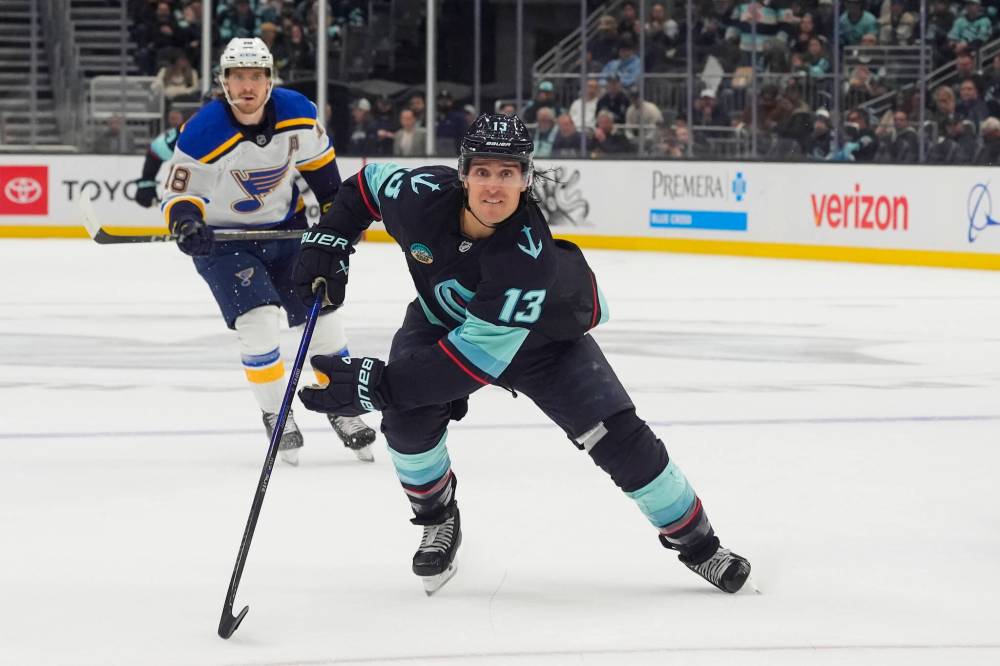
NEWARK – Winnipeg Jets general manager Kevin Cheveldayoff may not have hit it out of the park, but he didn’t go down looking either.
Whether or not that was the right path won’t be known for a couple of months.
After filling specific needs with a couple of experienced additions, the Winnipeg Jets know what they’ll be going into battle with as they leave this edition of the NHL trade deadline in the rear-view mirror.

George Walker IV / The Associated Press Files
The Jets acquired veteran defenceman Luke Schenn via a trade with the Pittsburgh Penguins.
“Part of our success as a group is that team identity. It’s one of those things where up and down, side to side, we have depth and we created a lot more there,” Cheveldayoff said before the Jets faced the New Jersey Devils on Friday night. “We have more speed. I think as you get into the playoffs that’s important. We have a hardness element that we didn’t have before. We have a champion in the room that has experience that will be a voice that will help our leadership group immensely.”
Bringing in veteran Luke Schenn should provide a boost for a blue line that was looking to add many of the qualities he brings to the table: championship pedigree and physical play, with an ability to clear the front of the net while also moving the puck efficiently enough.
Brandon Tanev is someone the Jets are quite familiar with, as the organization that signed him as a college free agent and watched him grow into someone who cashed in with a six-year deal with the Pittsburgh Penguins as an unrestricted free agent after putting up career highs on a line with Adam Lowry and Andrew Copp.
Tanev is an energetic winger who brings speed to the lineup and plays an in-your-face type of game while supplying secondary scoring.
He’s also a shot-blocking machine and someone who could be comfortable playing on the fourth line but also bump up and reunite with Lowry if circumstances arose.
Tanev played an important role on the checking line as the Jets made a run to the Western Conference final in 2018, something Cheveldayoff pointed out in his meeting with members of the media.
In short, the Jets should be harder to play against with Schenn and Tanev entering the fold.
As for the prices paid to acquire the assets, they’re in line with the high cost of doing business in and around the deadline.
Giving up second-round picks in 2026 and 2027 and a fourth-rounder in 2027 is a steep price, no doubt about that.
It’s a worthwhile for a franchise looking to get beyond the first round of the Stanley Cup playoffs for just the second time since 2018.
Cheveldayoff made it clear the prices weren’t a deterrent in his quest to upgrade the roster.
“That wasn’t a factor,” he said. “We weren’t going in saying, ‘We weren’t going to do this, we weren’t going to do that, we are going to do this, we are going to do that.’ We were prepared and ready to do whatever it took if there was fits.”
Did the Jets do enough to hold off the likes of the Dallas Stars and Colorado Avalanche, who made bigger swings, landed bigger players and addressed more needs?
The Jets definitely improved, but will it be enough to win 16 games this spring when the chips are down?
If you look at recent Stanley Cup champion history, you’ll find plenty of examples of teams that made modest moves at the deadlines to complement what was already a rock-solid roster as compared to being proclaimed deadline day “winners” as a result of reeling in a big fish or two.
The Jets are no doubt banking on that type of trend continuing.
There’s no doubt Cheveldayoff has taken some risk in not adding a second-line centre and that’s a match he tried to find right up until the deadline.
Although he didn’t mention him by name — because that would be tampering — Cheveldayoff left enough bread crumbs to suggest that they were likely one of the teams that was trying to acquire St. Louis Blues captain Brayden Schenn — either before or after the deal for Nelson fell through.
“Teams make decisions for whatever reason. They’re winning, team chemistry, injuries to their team and have to pivot and change their minds,” said Cheveldayoff. “You’re having many, many, many conversations weeks in advance leading up to this. And conversations can go one way or another for different teams for various different reasons. You can have someone on your list and planning and talking and cultivating for a long time and those things sometimes just don’t come to fruition.”

Lindsey Wasson / The Associated Press Files
The Seattle Kraken traded left wing Brandon Tanev to the Winnipeg Jets at the NHL trade deadline, Friday.
There are no participation ribbons handed out for being involved in trade talks for players that land elsewhere, but there was plenty of evidence the Jets were in the Brock Nelson sweepstakes before he joined the Avalanche.
Cheveldayoff didn’t want to get into the specifics of why the Jets couldn’t get that deal across the finish line, but if you read between the lines, it sounded like Nelson might not have wanted to go to a team playing in Canada or been willing to waive his trade protection.
“When decisions are made that are out of your control, that’s the way it is,” said Cheveldayoff. “We put a real strong foot forward and that’s where we’re at. The deals happen behind closed doors, they’re going to stay behind closed doors.”
The Jets are banking on Vladislav Namestnikov handling the job the way that he has for the entire season and for the depth of the group to ensure the team continues to lean on its defensive structure and score enough.
The other thing we know is Cheveldayoff has shown his belief in this core group numerous times during his 14-season tenure and he’s once again doubling down on the confidence he has in them.
There are many folks around the league who believed the Jets needed to do more to try and keep up with the Joneses.
“Little bit of an arms race going on,” said Jets head coach Scott Arniel. “When the one domino falls, others start to hit. There’s obviously some very, very big names going. I think that, like us, a lot of teams in the Central, we feel like we all have good teams that have a chance to win.
“They’ve made their moves, we’ve done stuff in different ways and it’ll really come down to the playoffs.”
Given the improvements made by the Stars (who added Mikko Rantanen after dealing for Mikael Granlund and Cody Ceci earlier) and Avalanche, it looks like finishing first in the Central Division and the Western Conference takes on more importance.
“I don’t think so, because we were talking about it in training camp. We talked about it the last couple of years, the importance of being the best in your division,” Arniel countered. “We know we have an extremely strong (division). We had a strong division before today, and it hasn’t changed.”
If the Jets are going to chip away at the narrative that’s been following them around after consecutive quick playoff exits, they’re going to have to apply some of the painful lessons learned and turn that into a longer run.
It doesn’t do them any good to wonder what the roster might have looked like with the addition of Nelson or a player like him.
There will be many observers who point to this day as a missed opportunity for the Jets, lamenting more wasn’t done to bolster their chances — especially with just over US$6 million still available under the salary cap ceiling, according to Puck Pedia.
That’s not of concern to the 25 players currently on the Jets roster or anyone that get recalled for the ride.
This is the group that the Jets have and it’s up to them to show what they can do when the stakes are highest.
ken.wiebe@freepress.mb.ca
X and Bluesky: @WiebesWorld

Ken Wiebe
Reporter
Ken Wiebe is a sports reporter for the Free Press, with an emphasis on the Winnipeg Jets. He has covered hockey and provided analysis in this market since 2000 for the Winnipeg Sun, The Athletic, Sportsnet.ca and TSN. Ken was a summer intern at the Free Press in 1999 and returned to the Free Press in a full-time capacity in September of 2023. Read more about Ken.
Every piece of reporting Ken produces is reviewed by an editing team before it is posted online or published in print — part of the Free Press‘s tradition, since 1872, of producing reliable independent journalism. Read more about Free Press’s history and mandate, and learn how our newsroom operates.
Our newsroom depends on a growing audience of readers to power our journalism. If you are not a paid reader, please consider becoming a subscriber.
Our newsroom depends on its audience of readers to power our journalism. Thank you for your support.



